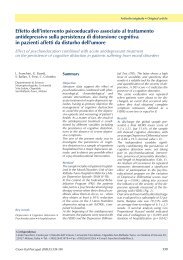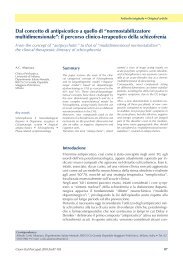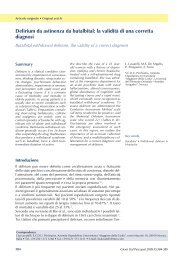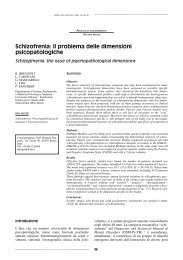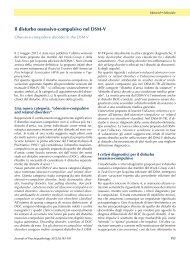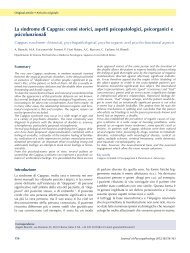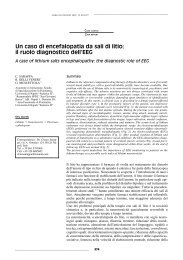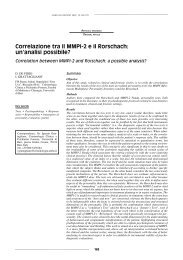XI Congresso della Società Italiana di Psicopatologia Psichiatria ...
XI Congresso della Società Italiana di Psicopatologia Psichiatria ...
XI Congresso della Società Italiana di Psicopatologia Psichiatria ...
Create successful ePaper yourself
Turn your PDF publications into a flip-book with our unique Google optimized e-Paper software.
Depressive Morbi<strong>di</strong>ty in Bipolar I Disorder<br />
R.J. Baldessarini<br />
Harvard Me<strong>di</strong>cal School, McLean Division of Massachusetts<br />
General Hospital Boston, Massachusetts<br />
Collaborators: Salvatore P, Tohen M, Khalsa HMK, Hennen<br />
J, Gonzalez-Pinto A, Imaz H, Tondo L, Baethge C,<br />
Ghaemi SN, Pompili M, Davis P<br />
Treatment of Bipolar I Disorder (BPD) has advanced greatly<br />
since the introduction of long-term treatment with<br />
lithium a half-century ago, inclu<strong>di</strong>ng recent ad<strong>di</strong>tion of a<br />
growing number of anticonvulsants and antipsychotic<br />
agents with antimanic, and variable mood-stabilizing properties<br />
(Baldessarini & Tarazi, 2005). Recurrences of mania-hypomania<br />
are highly effectively <strong>di</strong>minished by available<br />
treatments, but the depressive-dysphoric component<br />
of BPD remains a major, unsolved clinical challenge. Our<br />
recent stu<strong>di</strong>es document surprisingly high rates of morbi<strong>di</strong>ty,<br />
comorbi<strong>di</strong>ty, <strong>di</strong>sability, and mortality emerging early<br />
among first-episode BPD patients followed prospectively<br />
from illness-onset (Tohen et al., 2003; Tondo et al., 2003;<br />
Baethge et al., 2005). Despite treatment, unresolved morbi<strong>di</strong>ty<br />
was prevalent from illness onset (ca. 40% of followup<br />
time), and depressive-dysphoric illness accounted for<br />
nearly one-third of time-at-risk, as was found in mid-course<br />
in previous stu<strong>di</strong>es (Judd et al., 2002; Post et al., 2003;<br />
Joffe et al., 2004). In ad<strong>di</strong>tion, onset with depressive or<br />
mixed states anticipated an excess of later depressive and<br />
total morbi<strong>di</strong>ty, consistent with the concept that course<br />
and treatment response are less favorable when depression<br />
precedes mania as a course characteristic (Faedda et al.,<br />
1991). Moreover, risks of poor functional outcomes and<br />
perhaps substance abuse appear to be associated with depressive<br />
and other dysphoric affective components in BPD<br />
patients. Very importantly, excess depressive morbi<strong>di</strong>ty is<br />
a critical risk factor for the very high rates of suicide in<br />
BPD patients (Tondo et al., 2003). Treatment of depressive-dysphoric<br />
components of BPD remains very challenging.<br />
Currently available mood-stabilizers have only limited<br />
short-term and later protective effects vs. bipolar depression,<br />
and antidepressants appear to have a limited range<br />
of efficacy and safety, with or without ongoing moodstabilizing<br />
treatments (Ghaemi et al., 2004). A particularly<br />
important aspect of treating the depressive component<br />
of BPD is to reduce the risk of suicide, risk of which<br />
is at least as high or higher than in any other psychiatric<br />
<strong>di</strong>sorder, and at least 20-times greater than in the general<br />
SABATO 25 FEBBRAIO - ORE 9.15-10.00<br />
SALA CAVALIERI 1<br />
Lettura magistrale<br />
MODERATORE<br />
P. Castrogiovanni (Siena)<br />
13<br />
SESSIONI PLENARIE<br />
population. Our comprehensive meta-analysis of the effects<br />
of long-term treatment with lithium on risks of suicide<br />
and attempts in manic-depressive patients broadly defined<br />
found major protective effects, with reductions in both<br />
suicides and attempts by about 80%, with an increased attempt/completion<br />
ratio that suggests reduced lethality;<br />
supportive data included randomized controlled trials as<br />
well as other clinical stu<strong>di</strong>es (Baldessarini et al., 2005).<br />
Overall, the prece<strong>di</strong>ng fin<strong>di</strong>ngs strongly in<strong>di</strong>cate that depressive-dysphoric<br />
morbi<strong>di</strong>ty in BPD has major clinical<br />
significance and represents an unsolved therapeutic challenge<br />
for which new and improved treatments are urgently<br />
required.<br />
References<br />
Baethge C, Baldessarini RJ, Khalsa HMK, Hennen J, Salvatore P,<br />
Tohen M. Substance abuse in first-episode bipolar I <strong>di</strong>sorder:<br />
in<strong>di</strong>cations for early intervention. Am J Psychiatry<br />
2005;162:1008-10.<br />
Baldessarini RJ, Hennen J, Pompili M, Davis P, Tondo L. Decreased<br />
suicidal risk during long-term lithium treatment: a<br />
meta-analysis. Bipolar Disord 2005 (in press).<br />
Baldessarini RJ, Tarazi FI. Pharmacotherapy of psychosis and mania.<br />
In: Brunton LL, Lazo JS, Parker KL, ed. Goodman and Gilman’s<br />
Goodman and Gilman’s The Pharmacological Basis of<br />
Therapeutics, 11 th E<strong>di</strong>tion. New York: McGraw-Hill Press<br />
2005:461-500.<br />
Faedda GL, Baldessarini RJ, Tohen M, Strakowski SM, Waternaux<br />
C. Episode sequence in bipolar <strong>di</strong>sorder and response to lithium<br />
treatment. Am J Psychiatry 1991;148:1237-9.<br />
Ghaemi SN, Rosenquist KJ, Ko JY, Baldassano CF, Kontos NJ,<br />
Baldessarini RJ. Antidepressant treatment in bipolar vs. unipolar<br />
depression. Am J Psychiatry 2004;161:163-5.<br />
Joffe RT, MacQueen GM, Marriott M, Trevor Young L. A prospective,<br />
longitu<strong>di</strong>nal study of percentage of time spent ill in patients<br />
with bipolar I or bipolar II <strong>di</strong>sorders. Bipolar Disord<br />
2004;6:62-6.<br />
Judd LL, Akiskal HS, Schettler PJ, En<strong>di</strong>cott J, Maser J, Solomon<br />
DA, et al. Long-term natural history of the weekly symptomatic<br />
status of bipolar I <strong>di</strong>sorder. Arch Gen Psychiatry 2002;59:530-<br />
7.<br />
Post RM, Denicoff KD, Leverich GS, Altshuler LL, Frye MA,<br />
Suppes TM, et al. Morbi<strong>di</strong>ty in 258 bipolar outpatients followed<br />
for 1 year with daily prospective ratings on the NIMH life chart<br />
method. J Clin Psychiatry 2003;64:680-90.<br />
Tohen M, Zarate CA Jr, Hennen J, Kaur Khalsa HM, Strakowski<br />
SM, Gebre-Medhin P, et al. The McLean-Harvard First-Episode<br />
Mania Study: pre<strong>di</strong>ction of recovery and first recurrence. Am<br />
J Psychiatry 2003;160:2099-107.<br />
Tondo L, Isacsson G, Baldessarini RJ. Suicide in bipolar <strong>di</strong>sorder:<br />
risk and prevention. CNS Drugs 2003;17:491-511.




